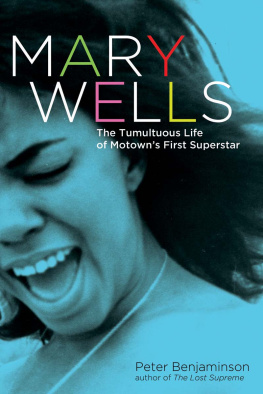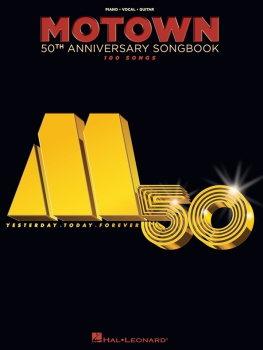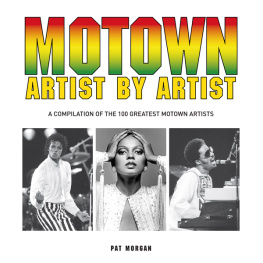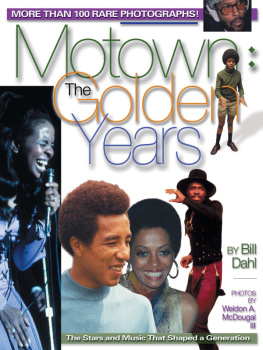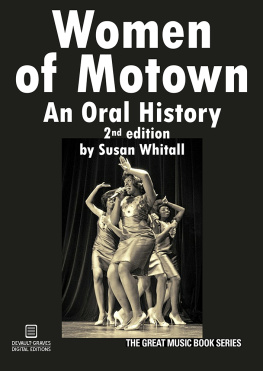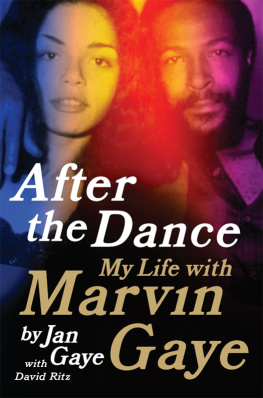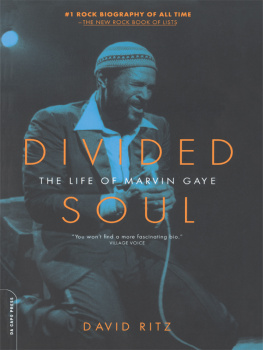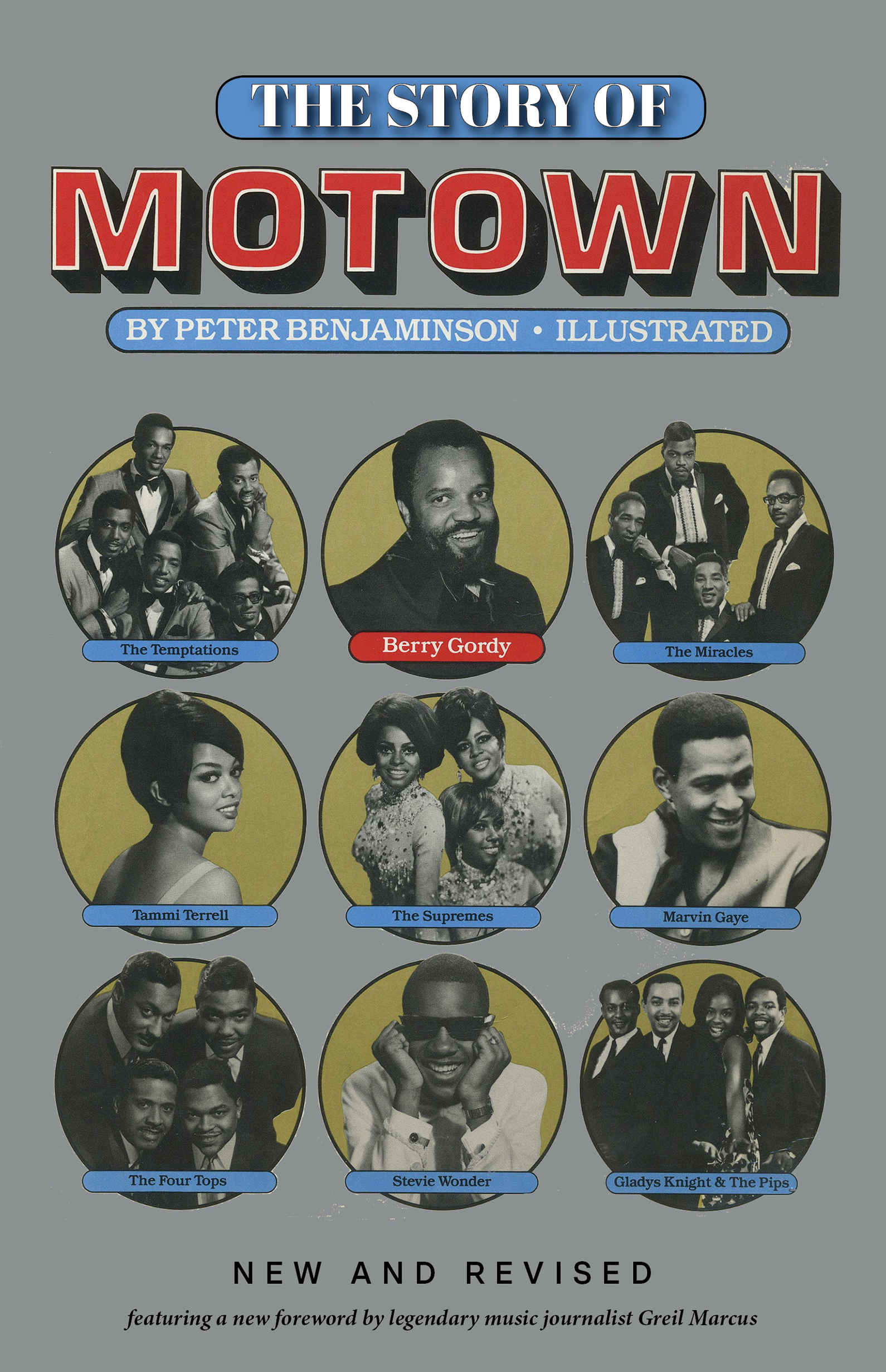This is a Genuine Barnacle Book
A Barnacle Book | Rare Bird Books
453 South Spring Street, Suite 302
Los Angeles, CA 90013
rarebirdbooks.com
Copyright 2018 by Peter Benjaminson
Originally published by Grove Press, New York, in 1979
All rights reserved, including the right to reproduce this book or portions thereof in any form whatsoever, including but not limited to print,
audio, and electronic.
For more information, address:
A Barnacle Book | Rare Bird Books Subsidiary Rights Department,
453 South Spring Street, Suite 302,
Los Angeles, CA 90013.
Interior photos provided by: Al Abrams, Thomas Bowles,
Detroit Free Press , Phil Jones, Steven Pines, Joe Porter, Phil Saviano,
Joe Shillair, Karl Wellman/ Monthly Detroit Magazin e
Set in Dante
epub isbn : 9781644280256
Publishers Cataloging-in-Publication data
Names: Benjaminson, Peter, 1945, author. | Marcus, Greil, foreword author
Title: The Story of Motown / by Peter Benjaminson; featuring new foreword by legendary music journalist Greil Marcus
Description: New and Revised | First Revised Trade Papaerback Edition |
A Genuine Barnacle Book | New York, NY; Los Angeles, CA:
Rare Bird Books, 2018.
Identifiers: ISBN 9781947856233
Subjects: LCSH Gordy, Berry. | Motown Record Corporation. | Sound recording executives and producersUnited StatesBiography. | Sound recording industryUnited States. | Soul musicHistory and Criticism. | BISAC MUSIC / Genre & Styles / Soul & R n B | MUSIC / History & Criticism
Classification: LCC ML429.G67 B4 2018 | DDC 338.7/61/789912dc23
THANKS TO Alan Abrams, Christine Brown Arnold, Charles Berry, Edward Boyer, Kent Carroll, Sandra Elkind, Carey English, Helen Fogel, Jennifer and Judith Frutig, Claudia Goldin, Richard Hafner, Ron Ishoy, Tim Kiska, Kurt Luedtke, Greil Marcus, Charles Mendoza, Tova Milinsky, Theodora Morales, Brownson Murray, Ladd Neuman, Alison and John Oppedahl, Alice and Jon Ratner, Mary Rousson, Jim Savage, Diane See, Lee Sobel, Bill Staiger, and Neal and Phyllis Shine. And my special thanks to the worlds greatest editor, my wife, Susan Harrigan.
Contents
F oreword
By Greil Marcus
When Peter Benjaminsons The Story of Motown was published in 1979, it was the first comprehensive book on the record label thatwhat? Changed the country? Brought black capitalism out of its funeral home empires and gospel emporiums and into the post-war twentieth century boom? Made Detroit as proud in the sixties as the Lions had made it in the fifties? Created records that, though recycled across six decades in countless cover versions by performers from every genre in pop music, through movies, TV shows, TV commercials, radio commercials, and Claymation commercials, remain inviolate and whole, speaking in their own voices, sloughing off the years theyve traveled like dust? When you hear Marvin Gayes I Heard It Through the Grapevine or the Miracles The Tracks of My Tears you dont think of The Big Chill . You hear dramas enacted, on their own terms, and you shake your head, stunned that anything could be this good, this perfect. But if these are perfect records, they are more than thator their existence as records cant enclose the story they tell. You could say Motown changed history itself: when it released Martha and the Vandellas Dancing in the Street in 1964, did anyone at Hitsville USA on West Grand Boulevard know, as people would discover, sing, and trumpet in Watts a year later and in Detroit, on Woodward Avenue, two years after that, that the song was about a riot, a refusal, a willingness to tear a city down to make it right? I wouldnt bet money that in 1964 someone didnt know.
There had been a short, flat, circumscribed study in published in the UK in 1971, David Morses Motown and the Arrival of Black Music . Scores of books have followed The Story of Motown : from boilerplate like Gerald Posners 2002 Motown: Music, Money, Sex and Power to such truly distinguished works as Raynoma G. Singletons 1990 Berry, Me, and Motown (Bury Me in Motown, as some people in Detroit called this blazing memoir by Berry Gordys second wife), Nelson Georges 1985 Where Did Our Love Go? The Rise and Fall of the Motown Sound and Gerald Earlys 1995 One Nation Under a Groove: Motown and American Culture , followed in turn by biographies and studies devoted to everyone from Berry himself to Diana Ross to Marvin Gaye to house band bassist and Funk Brother James Jamerson. Following the beginning of his career as journalist at the Detroit Free Press from 1970 to 1976, Benjaminson himself, for all of his years in New York with the Department of Investigation, the correction officers union, and the state Department of Labor, and journalism professor, has never left the Motown beat, publishing crucial books on Florence Ballard and Mary Wells. There are books to be found on single Motown albums and even an entire book on a single Motown single. The well is not dry, many of the central actors are dead but more are still alive, and they will be heard from one way or the other.
For all of that, The Story of Motown still delivers a charge you can find nowhere else. Its the sense of excitement and suspense that comes with a tale being fully made public for the first time. When the book appeared in 1979, twenty years after the beginning of the Motown fact with the release of its first record, Barrett Strongs Money (Thats What I Want) in 1959, that feeling of unveiling is patent and fierce, and it is just as strong now. Here is where Benjaminsons experience as a crime reporter, street reporter, city reporterprivately employed, but as well a kind of public actor, with a debt to the truth owed to the publiccomes into play.
Motown created events with the making, release, and marketing of its records. Millions of people were affected by those eventsand its not merely the notion that some of those people might be interested in the story of how that happened that powers Benjaminsons book. Its the conviction that everyone and anyone whose life was touched by what happened at Motown deserves access to that storywhich is to say, in a perhaps small but undeniable manner, access to their own lives. Thats perhaps why the story as Benjaminson tells it is, regardless of who he spoke to, who trusted him, whose trust he honored, an inside story, with the certainty that the betrayal is always more important than the promise, the secret more relevant than the verifiable fact. It is Motown as public domain.
With such a spirit animating the book, every detailfrom the start, the exemplary story of the Gordy clan from its beginnings in Georgia, Berry Gordys own beginning in the fifties hustling songs to Jackie Wilson (the list of hits he wrote or cowrote before anyone outside of small music circles knew his name is stunning: Reet Petite, Thats Why (I Love You So), Lonely Teardrops, more), the early Motown business model of making every 45 a hittakes on enormous pressure, the pressure that comes when any incident in the greater story, be that a decision, a hunch, a bet, an act of generosity or cruelty, a sacrifice made for the good of the company or the company sacrificing someone who was part of it, seems at once unlikely and inevitable. And that means, as one reads the book now, maybe already knowing how so many of the stories turned outMarvin Gaye turning both Motown and his own life inside out with Whats Going On in 1971 and then dead by his own fathers hand; Michael Jackson leaving the company in 1975, creating the biggest hit in history with Thriller in 1982, becoming perhaps the most famous person in the world by 1984, and dead from a drug overdose at fifty; the Contours Do You Love Me and a hundred other records sounding like miracles fifty years or more after they were madeyou keep turning the pages with the feeling that you dont know.



